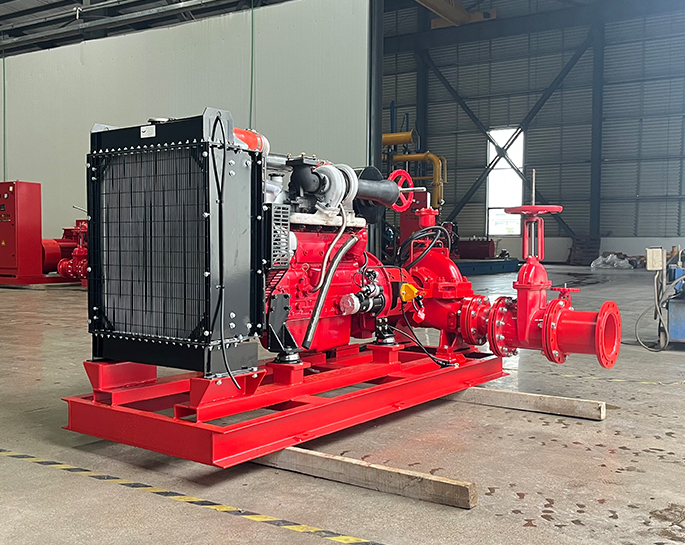What are the key components of a diesel fire pump system?
Mar 11, 2024
Share:
A diesel fire pump system is a critical component of fire protection systems in buildings and industrial facilities. It typically consists of several key components, each playing a crucial role in delivering water or other fire suppression agents to extinguish fires. Here are the key components of a diesel fire pump system:
1. **Diesel Engine**: The diesel engine is the primary power source of the fire pump. It provides the necessary mechanical energy to drive the pump and maintain water flow under pressure during fire emergencies.
2. **Fire Pump**: The fire pump is the heart of the system, responsible for drawing water from a water source (such as a tank, reservoir, or municipal water supply) and delivering it at high pressure to the fire protection system, including sprinkler systems, hydrants, or standpipes.
3. **Pump Controller**: The pump controller is an essential component that monitors and controls the operation of the fire pump. It typically includes features such as automatic start/stop functionality, pressure monitoring, alarms, and system status indicators.
4. **Fuel Tank**: The fuel tank stores diesel fuel required to power the diesel engine. It should be adequately sized to ensure sufficient fuel supply for the duration of a fire emergency.
5. **Fuel System**: The fuel system includes components such as fuel lines, filters, pumps, and valves that deliver diesel fuel from the fuel tank to the diesel engine. It should be designed and maintained to ensure reliable fuel delivery and prevent fuel leaks or contamination.
6. **Cooling System**: The diesel engine requires a cooling system to dissipate heat generated during operation and prevent overheating. This typically includes a radiator, cooling fan, coolant circulation pump, and associated piping.
7. **Exhaust System**: The exhaust system safely directs engine exhaust gases away from the operating area to prevent exposure to harmful emissions. It includes components such as exhaust pipes, mufflers, and ventilation ducts.
8. **Battery System**: Diesel engines typically rely on batteries to provide initial starting power. A reliable battery system, including batteries, charging system, and associated wiring, is essential for ensuring prompt engine startup during fire emergencies.
9. **Control Panel**: The control panel provides operators with user interfaces for monitoring and controlling the operation of the diesel fire pump system. It typically includes displays, buttons, switches, and indicators for monitoring system status and responding to alarms or faults.
10. **Safety Devices**: Various safety devices and features are incorporated into the diesel fire pump system to ensure safe operation and protect personnel and equipment. These may include emergency shutdown controls, overheat protection, low oil pressure shutdown, and automatic fault detection systems.
These key components work together to provide reliable and effective fire protection in buildings and industrial facilities, helping to safeguard lives and property in the event of a fire emergency. Regular maintenance, inspection, and testing are essential to ensure the proper functioning of the diesel fire pump system.

1. **Diesel Engine**: The diesel engine is the primary power source of the fire pump. It provides the necessary mechanical energy to drive the pump and maintain water flow under pressure during fire emergencies.
2. **Fire Pump**: The fire pump is the heart of the system, responsible for drawing water from a water source (such as a tank, reservoir, or municipal water supply) and delivering it at high pressure to the fire protection system, including sprinkler systems, hydrants, or standpipes.
3. **Pump Controller**: The pump controller is an essential component that monitors and controls the operation of the fire pump. It typically includes features such as automatic start/stop functionality, pressure monitoring, alarms, and system status indicators.
4. **Fuel Tank**: The fuel tank stores diesel fuel required to power the diesel engine. It should be adequately sized to ensure sufficient fuel supply for the duration of a fire emergency.
5. **Fuel System**: The fuel system includes components such as fuel lines, filters, pumps, and valves that deliver diesel fuel from the fuel tank to the diesel engine. It should be designed and maintained to ensure reliable fuel delivery and prevent fuel leaks or contamination.
6. **Cooling System**: The diesel engine requires a cooling system to dissipate heat generated during operation and prevent overheating. This typically includes a radiator, cooling fan, coolant circulation pump, and associated piping.
7. **Exhaust System**: The exhaust system safely directs engine exhaust gases away from the operating area to prevent exposure to harmful emissions. It includes components such as exhaust pipes, mufflers, and ventilation ducts.
8. **Battery System**: Diesel engines typically rely on batteries to provide initial starting power. A reliable battery system, including batteries, charging system, and associated wiring, is essential for ensuring prompt engine startup during fire emergencies.
9. **Control Panel**: The control panel provides operators with user interfaces for monitoring and controlling the operation of the diesel fire pump system. It typically includes displays, buttons, switches, and indicators for monitoring system status and responding to alarms or faults.
10. **Safety Devices**: Various safety devices and features are incorporated into the diesel fire pump system to ensure safe operation and protect personnel and equipment. These may include emergency shutdown controls, overheat protection, low oil pressure shutdown, and automatic fault detection systems.
These key components work together to provide reliable and effective fire protection in buildings and industrial facilities, helping to safeguard lives and property in the event of a fire emergency. Regular maintenance, inspection, and testing are essential to ensure the proper functioning of the diesel fire pump system.







